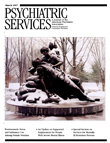Substance use among patients with a psychotic disorder in a psychiatric emergency room
Abstract
OBJECTIVE: This study used laboratory tests to identify current drug and alcohol users among psychotic patients seeking treatment in an urban psychiatric emergency room. Rates of clinician-suspected use and self-reported use were compared, as were treatment and disposition of users and nonusers. METHODS: Logistic regression modeling was used to identify factors that differentiated current substance users from nonusers in a sample of 112 psychotic patients. RESULTS: Laboratory analyses revealed that 24 of the 112 psychotic patients (21 percent) had used alcohol or an illegal substance before visiting the emergency room. Younger age, male gender, African-American ethnicity, clinician- suspected substance use, and presentation in the emergency room between 7 p.m. and 7 a.m. were associated with a higher likelihood of positive results on the urine test. Only five of the patients who had positive results (21 percent) self-reported substance use. Clinicians suspected that 59 patients (53 percent) were under the influence; however, only 17 of those suspected (29 percent) had positive laboratory results. Patients with positive laboratory results required more intense care in the psychiatric emergency room and were more often hospitalized. CONCLUSIONS: Some demographic and clinical factors were associated with concurrent substance use among psychotic patients in the emergency room. Clinicians' suspicions of use in this sample of psychotic patients lacked specificity due to the fact that potential use was suspected in a large number of cases for which laboratory results were negative. In contrast, self-reported use was uncommon among patients with positive results. Because neither clinician judgment nor patient self-report meaningfully predicts current substance use, routine urine drug screens may be appropriate.



